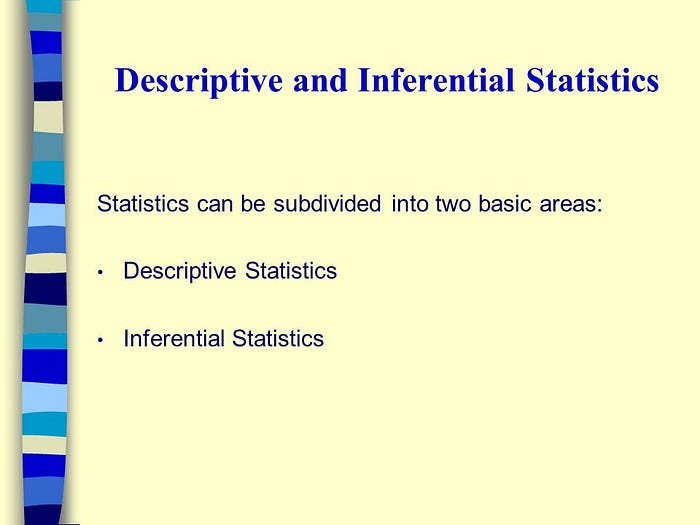Basic Statistics for Dummies 1
statistics is a branch of mathematics that deals with the collection, analysis, interpretation, and presentation of masses of numerical data to make inference and reach decisions in the face of uncertainty in economics , agriculture, education e.t.c
statistics can be subdivided into descriptive statistics and inferential statistics

Descriptive Statistics
Descriptive statistics are brief descriptive coefficients that summarize and describe a given data set, The most recognized types of descriptive statistics are measures of center: the mean, median, and mode, which are used at almost all levels of math and statistics.
Mean: The “average” number; found by adding all data points and dividing by the number of data points. (∑x)/N
Here,
∑ represents the summation
X represents observations
N represents the number of observations .
Example: The mean of 3, 2, and 7 is (3+2+7)/3 = 12/3 = 4
Median: The middle number; found by ordering all data points and picking out the one in the middle (or if there are two middle numbers, taking the mean of those two numbers).
Example: The median of 2, 1, and 5 is 2 because when the numbers are put in order (1, 2, 5), the number 2 is in the middle
Mode: The most frequent number — that is, the number that occurs the highest number of times.
Example: The mode of {4, 2, 4, 3, 3, 3}, is 3because it occurs three times, which is more than any other number.

inferential statistics
Inferential statistics allows you to make predictions (“inferences”) from that data. With inferential statistics, you take data from samples and make generalizations about a population.
Population: is the entire pool from which a statistical sample is drawn. A population may refer to an entire group of people, objects, events, hospital visits, or measurements.
Sample: is a set of element selected from a given population, Samples are also used in statistical testing when population sizes are too large for the test to include all possible members or observations.
Important Terms in Statistics
Average
also called mean; a number that describes the central tendency of the data
Parameter
a number that is used to represent a population characteristic and that generally cannot be determined easily
Population
all individuals, objects, or measurements whose properties are being studied
Probability
a number between zero and one, inclusive, that gives the likelihood that a specific event will occur
Proportion
the number of successes divided by the total number in the sample
Sample
a subset of the population studied
Variable
a characteristic of interest for each person or object in a population
Data
a set of observations (a set of possible outcomes); most data can be put into two groups: qualitative (an attribute whose value is indicated by a label) or quantitative (an attribute whose value is indicated by a number). Quantitative data can be separated into two subgroups: discrete and continuous. Data is discrete if it is the result of counting (such as the number of students of a given ethnic group in a class or the number of books on a shelf). Data is continuous if it is the result of measuring (such as distance traveled or weight of luggage)
Quantitative data
Quantitative data is defined as the value of data in the form of counts or numbers where each data-set has an unique numerical value associated with it, Quantitative Information — Involves a measurable quantity — numbers are used. Some examples are length, mass, temperature, and time.
Qualitative data
Qualitative data is non-numerical data that is observed, descriptive, and subjective. Examples of qualitative data include sex (male or female), name, state of origin, citizenship, etc. A more practical example is a case whereby a teacher gives the whole class an essay that was assessed by giving comments on spelling, grammar, and punctuation rather than score.

Types of Quantitative data
(1) DISCRETE DATA
(2)CONTINUOUS DATA
DISCRETE DATA
Discrete data is information that can only take certain values (countable or finite) examples :
- The number of students in a class.
- The number of workers in a company.
- The number of parts damaged during transportation.
- Shoe sizes.
- Number of languages an individual speaks.
- The number of test questions you answered correctly.
CONTINUOUS DATA
Continuous data are data that can take any value (within a range).
Example: People’s heights could be any value (within the range of human heights), not just certain fixed heights.

If you liked it, follow me for more publications and don’t forget, please, give it an applause!
